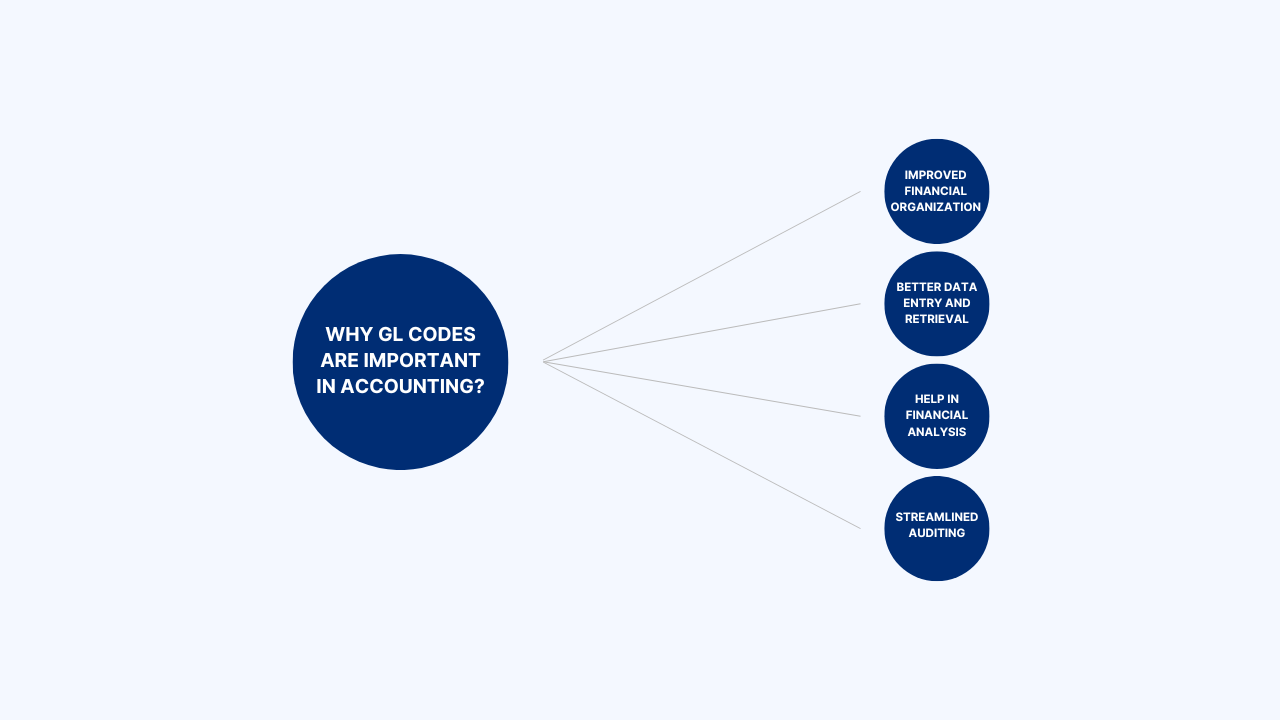1. 80% of businesses report streamlined financial tracking after implementing GL codes, improving accuracy and reporting.
2. 90% of organizations utilize GL codes to standardize accounting processes across departments, enhancing clarity.
3. Companies see a 30% decrease in errors after adopting GL codes for categorizing transactions.
4. GL codes ensure 70% better regulatory compliance by clearly tracking and recording financial data.
In every finance and accounting conversation, “GL code” is one of the hot topics you will hear often.
But, what exactly is it and why is it even significant in discussions related to finance?
A GL code, which is short for “General Ledger Code”, is basically considered a unique identifier to document and keep a tab on financial transactions within a company’s general ledger.
A GL is a giant, master record that comprises all information on financial transactions that happen on a day-to-day basis in a business.
For example, do you keep hearing names like income, expenses, assets, or liabilities? It all happens in the general ledger.
Now, coming back to the topic, GL codes are labels that help to classify and put a name against every transaction.
Here’s a detailed guide on GL codes.
Importance of GL Codes in Accounting
As you know, GL codes are known to classify every transaction, regardless of what form. From sales revenue, utility bills to salaries and wages – every entry that you see has an assigned GL code. This just makes the process easier and organized, with little to no efforts spared in locating any important item. That’s just one way to say why it is so important. There are a lot of other reasons, too. So, let’s look at them in detail.

1. Improved financial organization
GL codes are nothing less than an awesome “organizational tool” that helps keep everything in order, reducing the amount of errors. In simple words, because of its ability to categorize all financial transactions, it makes it easier for businesses to keep their finances away from chaos. Most importantly, it guarantees that every penny you see (or don’t) is accounted for in its proper place.
2. Better data entry and retrieval
It is easy to streamline the process of entering any form of data into the accounting system with GL codes. Isn’t that amazing? In all cases, it helps simplify the retrieval of financial information. Every information you search for (be it expenses or liabilities), GL codes make the process much quicker and easygoing.
3. Help in financial analysis and reporting
GL codes make it incredibly easy to draft reports or analyze financial data. With GL codes, you can quickly aggregate every related transaction. This can be a major help. How? It makes it easier to monitor financial performance, recognize trends, and make wise decisions after gauging every little detail.
4. Streamlined auditing
As you already know, auditors rely big time on GL codes to review and understand whether the information on the company’s financial statements is accurate. With GL codes, you can streamline the auditing process by easing down the cumbersome process of tracing transactions via the accounting system. This can be highly advantageous if you want to stay on the right side of the bed by complying with accounting regulations and current standards.
This is still not enough. There are many more reasons that make the GL code important in accounting. From budgeting and forecasting to improved internal controls – there are endless names to the list. Now that you know about its importance, let’s understand what GL code is, in detail.
Understanding in-depth: What is a GL Code?
Many ask about the GL code meaning and want a detailed explanation of what it is. Well, GL codes are basically the shorthand used in accounting that helps categorize and track financial transactions in a business’s general ledger. More often than not, several people also agree that the GL code is the brain of the company’s data.
In simple words, GL codes are unique identifiers represented as alphanumeric codes assigned to every account in the general ledger. That means, it stores information, as labels, and assigns it to each account.
There are several components to a GL code, too, and it is important that you learn about them:
- Account type: This basically houses the broad category of the transaction element, including but not limited to revenue, expenses, assets, and liabilities. Account types make it easier to comprehend how a transaction impacts the company’s financial situation.
- Account Category: There’s no doubt that for every account type, there is a dedicated subcategory right under its umbrella. For instance, if you look closely under expenses, you may encounter categories that read, “payroll expenses”, “marketing expenses”, and “travel expenses” – among many others. When you check with this much detail, you can make more granular analysis and tracking of your financial operations.
- Account number: This is basically a unique identifier for every account in a category. The account number, among all, is the one that helps to differentiate one account from another that are under the same category or type.
Challenges of Manual GL Code Management
There’s a reason why we say that it’s time to automate your manual GL management. Why? To understand that better, we have to closely look at some of the major challenges that manual GL code management has. So, without any delay, let’s get into it:
Time-consuming nature of manual entry and management
It can be incredibly tedious and exhaustive to assign and manage GL codes manually. This holds especially true for large transaction volumes. This takes up time that could be better used for strategic and higher-level analysis tasks. To top it off, it is extremely difficult to maintain accuracy and consistency across so many departments and users.
Potential for errors and inconsistencies
As the saying goes, “To err is human”. If you are using manual data entry, there’s a high risk of errors and discrepancies. From small typos and brief misinterpretations to a massive issue of incorrect code selection – it can be absolutely anything, and you will not have any ounce of control over it. The inconsistencies will then lead to improper financial reporting. On top of that, you will not be able to gauge how time-consuming and resource-intensive the whole process is going to be.
Difficulty in scalability and adaptation to changes
It is undeniable that you will lose the race if you keep sticking to manual GL code management. As your business evolves and financial operations become more sophisticated, you will not be able to manage GL code with pristine attention anymore. However hard that may sound, it is true. Moreover, it can be difficult to update or add new codes to meet evolving reporting needs or business process changes. There is a major disadvantage this can often bring. The lack of flexibility. In simple words, this apparent “lack of flexibility” will prevent proper financial analysis and sound decision-making.
These are some of the top challenges manual GL management brings. That’s part of the reason why you should consider automating it for better efficiency, scalability, and added accuracy – at all costs.
Need help with automating your GL codes?
Talk to our expert accountants.
How to Automate GL Codes?
Let’s understand some of the ways you can use to automate GL codes:
Selection of appropriate accounting software or tools:
This is where you choose the one that fits your exact needs. Choose a software that can provide:
- Rule-based automation: You have to set some rules that can automatically assign GL codes based on the information fed as per vendor name, transaction type, or any specific keyword that can be extracted from invoices.
- Use machine learning: You can always choose an AI-powered tool that starts to understand your historical coding patterns and anticipate the closest GL code for new transactions.
- Integration with the existing systems: You have to make sure whether your existing accounting software, ERP system, and other associated platforms are compatible with it for seamless flow of data.
Setting up a standardized GL code structure
When you set up a standardized GL code structure, you can get accurate and consistent automation. Let’s break down into detail:
- Transparent and concise naming conventions: Always make sure that you are using meaningful names only that show the purpose of every GL code.
- Hierarchical structure: Make sure you are organizing codes into logical groups on the basis of their nature (for example, it can be anything like expenses, liabilities, or assets).
- Documentation and training: This is one of the most integral areas as you need to clearly document your GL code structure in order to train relevant users on how to apply it consistently.
As a note, never forget that automation of GL code is not actually a “set it and forget about it” solution. When you set it up, ongoing monitoring and maintenance are extremely important in order to guarantee accuracy and adaptation to changes that occur in a business.
Want help selecting the right tools for GL codes automation?
Connect with our automation support group.
Benefits of Automating GL Codes
There is a huge list of benefits that come with automating GL codes. Let’s look at a few of them in detail:
1. Increased accuracy and consistency
Without a doubt, automation helps reduce the possibility of human error that comes with manual data entry. This can lead to more reliable and readable financial data. As of today, standardized rules and several machine learning models now guarantee consistent GL code application across all transactions. In reality, it reduces the chances of inconsistencies between users and departments, making financial reporting a breeze.
2. Time and cost savings
You can focus on all higher-level analysis if you automate several repetitive tasks, including but not limited to GL code assignment. Reduced errors also translate into less time spent reconciling and fixing errors. Thus, it also helps to increase productivity on multiple levels. What else? Reducing the need for manual labor through improved automation may also result in cost savings.
3. Enhanced scalability and adaptability
As we mentioned earlier, your business will keep growing with time and resources, and it will evolve into a bigger structure. Automated systems can easily bulk load this increased transaction volume without ever compromising on accuracy. Moreover, it becomes far easier to add new GL codes or update the existing ones. This is an added benefit because you can adapt your reporting structure according to your needs.
4. Improved reporting and analysis capabilities
When you receive more accurate and consistent data from an automated GL code, it enables greater reliability in financial reporting. In fact, automated codes offer a deeper sneak peek into the insights of spending patterns, trends, and performance metrics. This largely enables deeper analysis of different departments, projects, or cost centers.
Examples of GL Code Automation
Let’s see a GL code example to understand it even better.
Case scenario: Automating recurring invoices
Let’s assume a company, Acme, receives several bundles of invoices every month from the same supplier, PaperName & Co., for their office supply needs. In this case, if you try to manually assign GL code to every transaction, it can eventually drain you and become error-prone.
This is where automation can come up as a rescue. Let’s look at the solution it can bring.
Automation Solution
- The first step could usually be to recognize “PaperName & Co.” and classify their invoices as “office supplies” expenses.
- The second step would be to set up an automation rule in the accounting software of Acme that identifies invoices from PaperName & Co. and assigns a GL code to it.
- As an option, you can also train the automation tool to identify certain keywords that relate to office supplies, such as “papername”, “printer ink”, or “A4 papers” within the invoice description for a more enhanced GL code assignment.
There are several benefits to following automation and leveraging it in the long term. For instance:
- a) Reduced manual effort and less resource-intensive.
- b) Mitigated human errors and guaranteed data integrity.
- c) Better and quicker processing with enhanced tab on payment timelines.
Best Practices for Automating GL Codes
If you don’t want to miss out on making your financial operations simpler and streamlined, these are some best practices curated just for you:
Regular maintenance and updates of GL code structure
- Cleanse data: Are you regularly monitoring your GL codes to understand its accuracy and relevance? If not, the time is now. Start monitoring, cleanse obsolete accounts, and consolidate barely used accounts to make the system more streamlined.
- Update as per changes: Undoubtedly, the requirements of a business will be subject to change, just as its regulatory environment. That means, it’s best to regularly update your GL code structure to showcase the changes in your business, legalities, and other accounting standards. Read more about GAAP accounting standards here.
- Standardize naming conventions: Don’t complicate a very easy process. To preserve uniformity throughout the ledger, make sure that newly created GL codes stick to established naming conventions and structure guidelines.
Periodic review and reconciliation of accounts
- Arrange regular reconciliations: If you want to catch major or minor hiccups early on, it’s best to have an established schedule for reconciling accounts to catch and fix errors as soon as possible.
- Assess variations: Always use automated tools to accentuate substantial variances from the good-to-go, normal patterns to make investigation more in depth. This can help you recognize any form of error or fraud.
- Evaluate Automated Entries: Validate automated entries on a regular basis to make sure the automation rules are current and operating as planned.
Data security measures
- Understand your controls: Always establish strict, unbreakable access controls to make sure that only the authorized can make necessary changes. This can mitigate the high risk of tampering with fragile data.
- Use backups and encryption: There’s no guesswork here. Without a flinch, use encryption to prevent the chances of risk exposure. Moreover, always have a backup to avoid losing important data during cyberattacks and system failure.
Continuous improvement and optimization of automated processes
- Take feedback: This is one of the most important areas, which unfortunately, many miss out on. Always gather feedback from users and departments of the GL system to get a hold on pain points and assess areas for improvement.
- Use new technologies: Make sure that you are informed and tuned with all new accounting technologies and software updates because they can improve GL code automation, taking it to a whole new level. For instance, many use AI and machine learning for error identification and predictive analysis.
- Never forget to evaluate performance: Create metrics to assess the effectiveness of the automated GL code system and its influence on financial operations. Utilize this information to inform future developments.
In wrapping up
Gone are the days of manually entering GL codes for each transaction into a spreadsheet or a specialized tool. Because, why would you anyway?
Manual GL code assignment is cumbersome, tedious and time-consuming.
With GL code and its automation, you can be free from the fear of errors and manual labor – that costs you time and extra resources. As people say, GL code is the core of all your operations and houses important data that you would not like to lose. So, do it the easier and more streamlined way to avoid any type of risk.
Have any more questions outside of what you see here? Get in touch with our accounting and bookkeeping professionals who have the right amount of expertise to help you in the best way possible.












